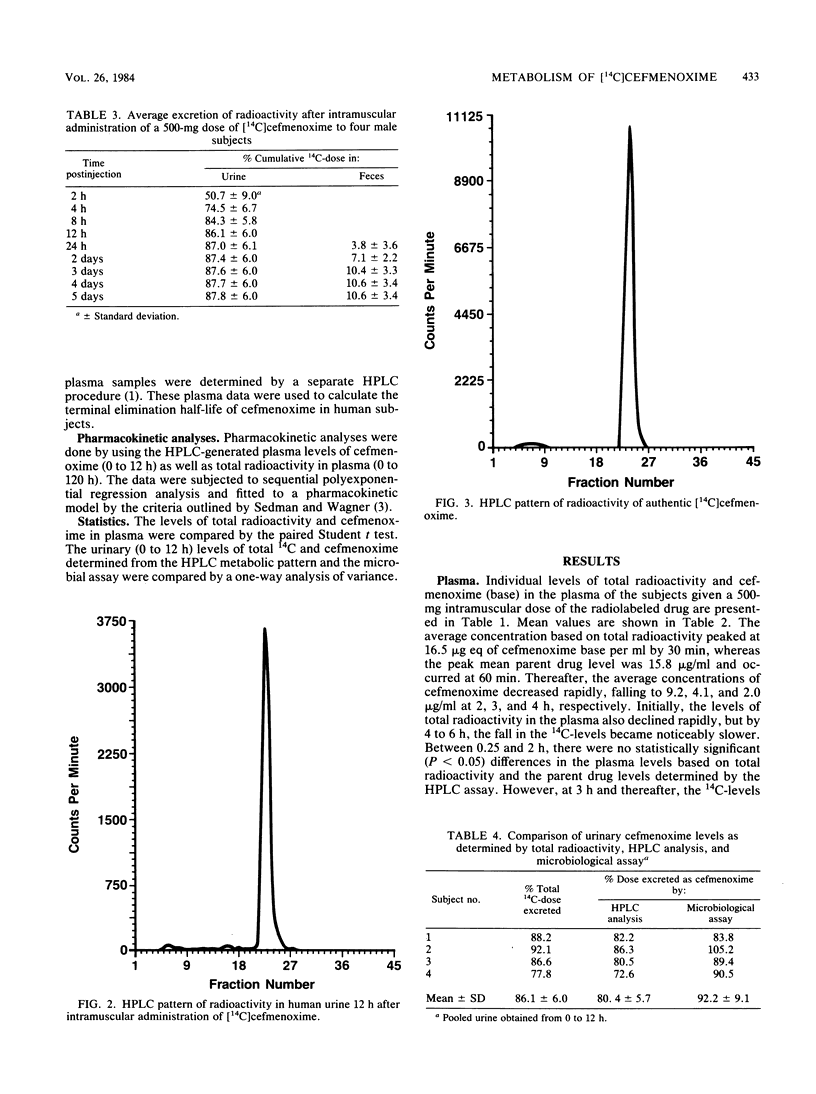Abstract
The metabolism of cefmenoxime (SCE-1365) was studied in four healthy male volunteers after intramuscular administration of a single 500-mg dose of the 14C-labeled drug. Plasma levels of total radioactivity and cefmenoxime peaked at 0.5 and 1.0 h, corresponding to 16.5 micrograms eq/ml and 15.8 micrograms/ml, respectively. Thereafter, parent drug levels declined rapidly, with a terminal elimination half-life of ca. 1.5 h. No significant differences were noted between total radioactivity and parent drug levels up to 2 h after drug administration. After 3 h, low but persistent levels of radioactivity were significantly greater than parent drug levels, indicating metabolism or degradation of cefmenoxime. The terminal elimination half-life of total radioactivity was estimated to be ca. 40 h. The radioactive plasma metabolite(s) remaining at the end of the 5-day study represented only 1% of the administered dose. Urinary excretion was the major route of elimination of cefmenoxime, accounting for ca. 86% of the dose in 12 h. Analysis of cefmenoxime in urine by total radioactivity, high-pressure liquid chromatography, and a microbiological assay showed that 80 to 92% of the excreted dose was parent drug. Radioactivity was also excreted into the feces via the bile and represented ca. 11% of the dose after 5 days. Although extensive degradation of cefmenoxime was found in fecal samples, it was proposed that this may be due to the metabolic activity of the intestinal flora rather than in vivo biotransformation in the liver. This study supports the concept that cefmenoxime undergoes minimal metabolism in humans and is excreted largely as unchanged drug.
Full text
PDF




Selected References
These references are in PubMed. This may not be the complete list of references from this article.
- Granneman G. R., Sennello L. T. A very precise high-performance liquid chromatographic procedure for the determination of cefmenoxime, a new cephalosporin antibiotic, in plasma. J Chromatogr. 1982 Apr 16;229(1):149–157. doi: 10.1016/s0378-4347(00)86046-6. [DOI] [PubMed] [Google Scholar]
- Granneman G. R., Sennello L. T., Steinberg F. J., Sonders R. C. Intramuscular and intravenous pharmacokinetics of cefmenoxime, a new broad-spectrum cephalosporin, in healthy subjects. Antimicrob Agents Chemother. 1982 Jan;21(1):141–145. doi: 10.1128/aac.21.1.141. [DOI] [PMC free article] [PubMed] [Google Scholar]
- Tanayama S., Yoshida K., Adachi K., Kondo T. Metabolic fate of SCE-1365, a new broad-spectrum cephalosporin, after parenteral administration to rats and dogs. Antimicrob Agents Chemother. 1980 Oct;18(4):511–518. doi: 10.1128/aac.18.4.511. [DOI] [PMC free article] [PubMed] [Google Scholar]
- Tsuchiya K., Kita Y., Yamazaki I., Kondo M., Noji Y., Fugono T. Absorption, distribution and excretion of cefmenoxime (SCE-1365), a novel broad-spectrum cephalosporin, in mice, rats, rabbits and dogs. J Antibiot (Tokyo) 1980 Dec;33(12):1532–1544. doi: 10.7164/antibiotics.33.1532. [DOI] [PubMed] [Google Scholar]


